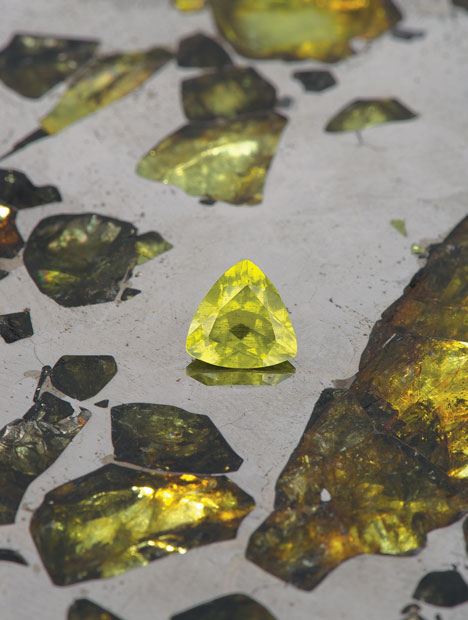GIA Tests Extraterrestrial Gemstones for Down-to-Earth Elements

Peridot, an olive-green gem also found here on Earth, has been recovered from meteorites on occasion, and even faceted into gemstones, though specimens are so rare that you’re unlikely to find them in a jeweler’s showcase. But researchers at GIA (Gemological Institute of America) assembled 26 extraterrestrial samples to discover the differences between them and their earthly counterparts. The findings are reported in GIA’s Gems & Gemology’s Fall 2011 issue.
Peridot is the gem version of a mineral called olivine, an iron and magnesium silicate -- (i.e. containing silicon). Olivine is part of the makeup of our solar system neighbors, including some metallic meteorites that occasionally fall on our home planet. While such peridot-bearing meteorites are rare enough, the intense heat from their journey to Earth and their explosive impact on contact with terra firma ensure that few specimens survive intact. That’s why peridot pieces from outer space are nearly always quite small.
Peridot from Earth’s own deposits was one of the first gemstones treasured by mankind. The ancient Egyptians called it “the gem of the sun” after discovering a deposit in what’s now known as St. John’s Island in the Red Sea. Today, sources include the United States (Arizona, Texas and Hawaii), China, Myanmar and Pakistan, which produces many of the largest, finest specimens. Peridot’s attractive color and relatively modest price have made it popular with jewelry designers around the world.
GIA researchers Dr. Andy Shen, John Koivula and Dr. James Shigley assembled specimens from several terrestrial locales and compared them with 26 samples taken from the Esquel meteorite, the most notable peridot-bearing extraterrestrial object.
Discovered in Argentina about 50 years ago, this massive meteorite contained numerous peridot crystals. An American collector purchased most of the Esquel in 1992 and divided it into a number of sections for sale. Three of the Esquel samples examined by GIA were faceted gemstones, while the others were part of polished slabs.
Using a laser beam and sophisticated mass spectrometry that can detect tiny amounts of elements within gemstones, the GIA team discovered significant differences between earthly and extraterrestrial peridot. Their tests found different levels of lithium, vanadium, nickel, manganese, cobalt and zinc between the two, allowing researchers and ultimately gem buyers to confidently distinguish between peridot of different worlds.

A section of the translucent Esquel meteorite reveals a kaleidoscope of peridot crystals from outer space. Courtesy of Robert A. Haag; photo by GIA/Robert Weldon.

This richly colored 1.12 carat extraterrestrial peridot was extracted from the massive Esquel meteorite, a polished section of which rests behind it. Courtesy of Robert A. Haag; photo by GIA/Robert Weldon.



